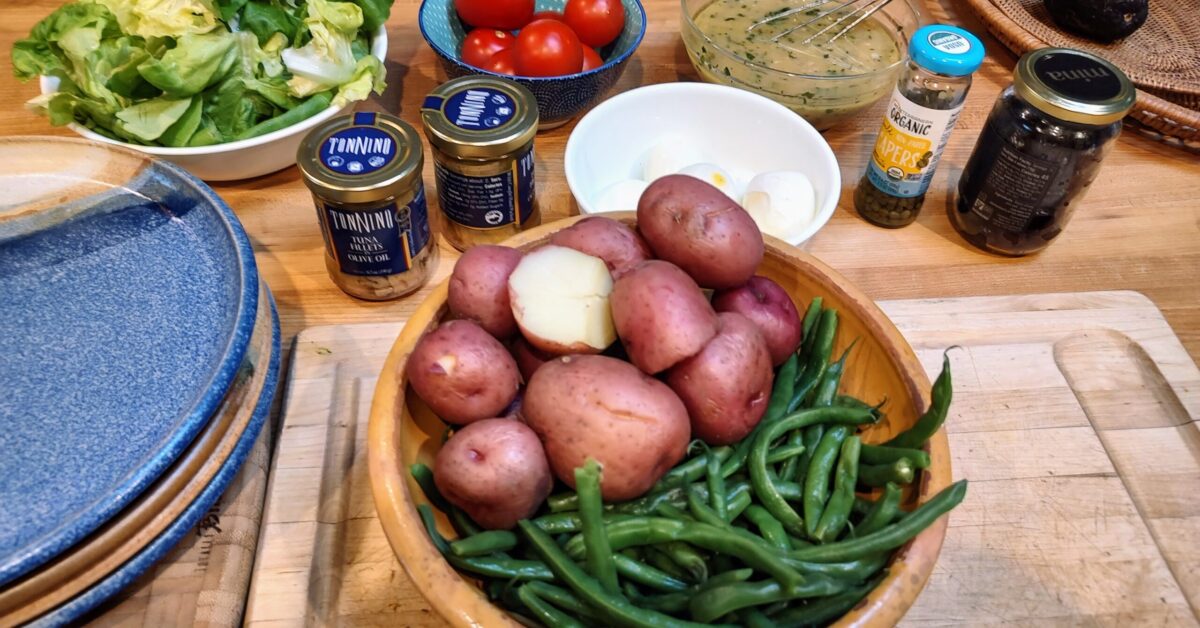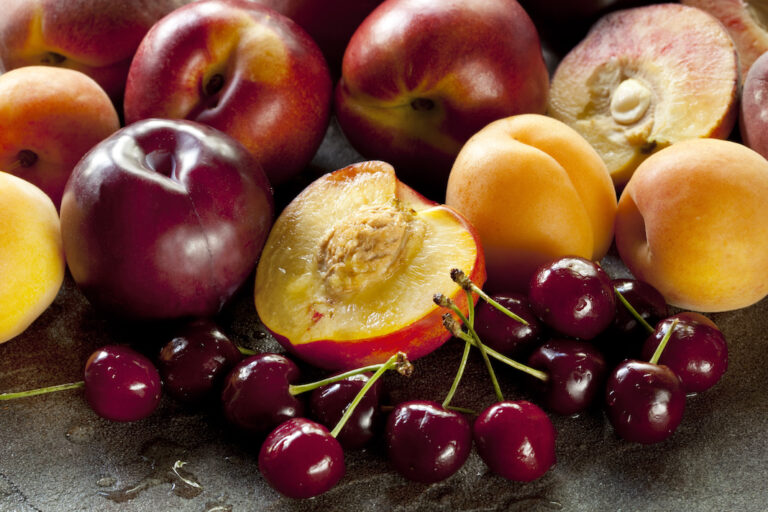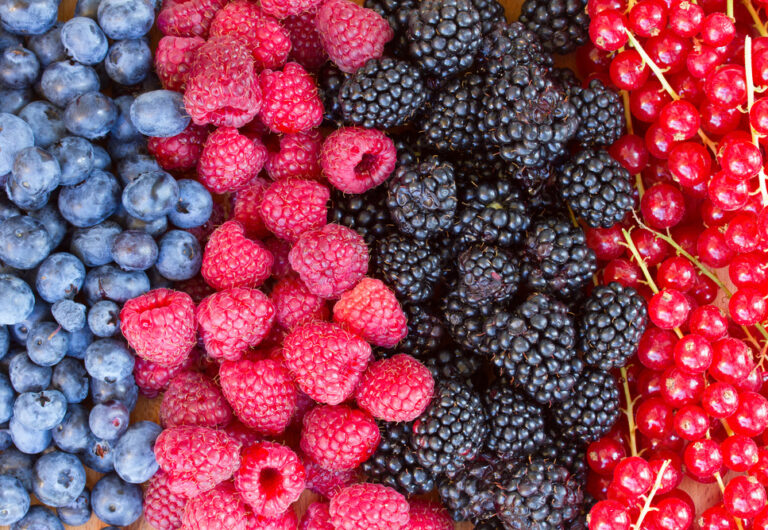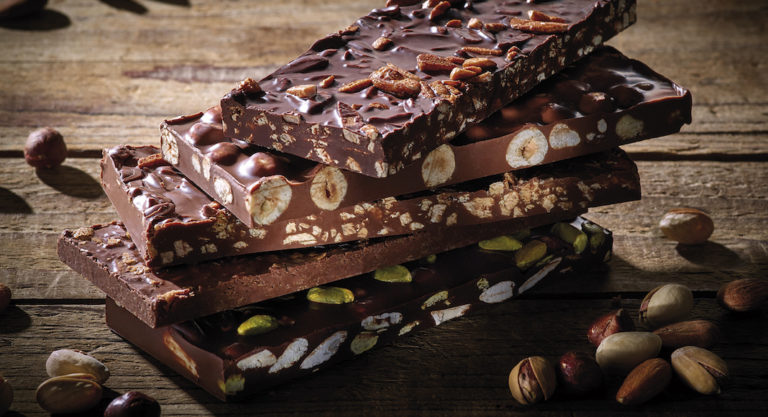This quintessentially French salad is universally beloved, but the agreement ends there. As Nigella Lawson put it, understatedly, “Everyone seems to have a very strong opinion as to what should or should not go into a Salade Niçoise.”
The recipe originated in late 19th-century Nice as an affordable dish for poor people, a quick assembly of cheap ingredients: tomatoes, anchovies, and olive oil, a thing of perfect simplicity. So naturally, the inevitable additions and alterations to the basic recipe have fomented an ongoing heated debate. What, exactly, is allowed in it, and how should it be made? Composed or tossed? Fresh fish or canned? Tuna or anchovies or both? Cooked vegetables or strictly raw? Lettuce? Corn? And what about the dressing? Vinegar or no vinegar? Mayonnaise, you say? Sacré bleu!
In my own admittedly American opinion, a Salade Niçoise is a loose, artful arrangement of opposing textures and tastes: sweet ripe tomatoes and salty chewy olives, crisp green beans and crumbly hard-boiled eggs, crunchy lettuce and fork-soft potatoes, briny oil-packed fish and piquant capers and shallots, all bound together in a fresh lemony dressing. When I dig into a plate piled high with all this resplendent bounty, I try to assemble as many ingredients as I can together in one forkful for a burst of zingy contrast in every bite. It’s sublime.
But many far more qualified cooks would and do vehemently disagree with my version. The former mayor of Nice himself, a cookbook author named Jacques Médecin, insists that you begin by rubbing a wooden salad bowl with a garlic clove, and “never, never, I beg you, include boiled vegetables in your Salade Niçoise.” His 1972 recipe calls for a composed arrangement, predominantly tomatoes, “salted three times and moistened with olive oil,” along with either anchovies or tuna, and “the crisp, sweet flavours of the vegetables of the Midi,” meaning southern France. According to Niçoise purists, these may include raw cucumbers, black olives, purple artichokes, and fava beans, but vehemently notAuguste Escoffier’s inclusion of cold cooked green beans and potatoes, additions which to this day are forbidden by a local organization called Cercle de la Capelina d’Or, which exists solely to preserve the purity of traditional recipes. (They point out that Escoffier was born near Nice, but was not, in fact, Niçois, so what did he know?)
Despite these stringent protestations from the natives, the 1938 Larousse Gastronomique calls for “equal parts diced potatoes and French beans. Season with oil, vinegar, salt, and pepper. Mix with anchovy fillets, olives and capers. Garnish with quartered tomatoes.” I shudder to imagine the reaction of the good people of the Cercle.
Salade Niçoise debuted in America in the 1920s as a product of hotel chefs, who popularized two versions, one with anchovies, one vegetarian. But the wide disagreement as to the proper ingredients traveled across the Atlantic with the dish: Julia Child’s Mastering the Art of French Cooking included the scandalous cooked green beans and potatoes. And it devolved from there: James Beard added rice for an Uncle Ben’s advertising campaign. Emeril Lagasse calls for parmesan in his dressing. Cat Cora makes a Niçoise lettuce wrap. Mark Bittman puts farro in his. Guy Fieri’s has mushrooms and couscous.
Okay then! Seriously, people, it’s August, and it’s hot, and we’re hungry, and who among us is strong enough to resist the subversive joy of doing whatever we want in the privacy of our own kitchens? If the likes of Child and Bittman and Fieri can do it, then so can we.
My own version comes from an issue of Cook’s Magazine from the early oughts. I followed the recipe a few times, and then I wandered off into the underbrush and started making it my own way. I made it recently with fresh herbs picked from my mother-in-law’s thyme and tarragon bushes, which grow behind our casita in Taos. In return for this bounty, I made plates of salad for the four of us in my parents-in-laws’ kitchen, and we all feasted until every scrap was gone, empty plates gleaming with olive oil.
So I’ll give you my recipe, which of course I think is the best one, with the sure knowledge that you will deviate from it. Because a perfect, authentic Salade Niçoise turns out to be whatever the hell any cook wants it to be.
Salade Niçoise
On a large platter or 4 individual plates, make a bed of washed, dried lettuce leaves: Boston or butter are best. A combination of red- and greenleaf is good, too.
Divide and arrange on the lettuce in discrete mounds the following ingredients for four people:
6 sliced ripe tomatoes, 6 peeled quartered-lengthwise hard-boiled eggs, a pound of haricots verts or green beans steamed then blanched in ice water, 6 boiled sliced red potatoes or 12 new ones, 30 or so black wrinkled salty Niçoise olives, and 2 cans of drained olive-oil packed tuna, lightly flaked with a fork.
Sprinkle a handful of capers over everything.
The following dressing is perfect. You will no doubt use it as a base from which to rebel, by which I mean innovate:
Whisk high-quality olive oil (you can include some of the oil drained from the tuna if you want to add even more fishy umami) into the juice of 1 juicy lemon or 2 harder ones until it thickens and emulsifies into cloudiness and tastes just tart enough for your liking when you dip a finger in. It usually takes a lot more oil than you think it should, on the order of around a cup. Add 1 finely minced shallot and 1 large minced garlic clove, a tablespoon of anchovy paste or 1-2 minced anchovies, a handful each of minced fresh thyme and tarragon, plus sea salt and black pepper to taste.
I don’t bother with the fussy technique of individually dressing each ingredient before you add it to the salad. I say, drizzle it over everything with abandon.
Kate Christensen is a novelist, memoirist and food writer based in Taos, New Mexico. This essay is the sixth in a monthly series about French food called Bouffe, created and written exclusively for Frenchly by Kate Christensen. Her books, Blue Plate Special, How to Cook a Moose, The Last Cruise and more can be purchased here, on Amazon. Her next book, a novel, will be published in 2023.
All photos are courtesy of the author.












